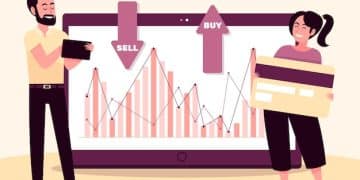Federal Reserve Announces 0.25% Interest Rate Hike: What It Means for You

The Federal Reserve has announced a 0.25% interest rate hike today, signaling its continued efforts to combat inflation. This decision impacts various aspects of the U.S. economy, from borrowing costs for consumers and businesses to the overall stability of the financial markets.
The Federal Reserve’s announcement of a 0.25% interest rate hike today has sent ripples through the financial world. But what does this mean for you, the average American? Let’s delve into the implications of this decision and how it might affect your wallet.
Understanding the Federal Reserve’s Decision
The Federal Reserve, often referred to as the Fed, plays a crucial role in managing the U.S. economy. One of its primary tools is the federal funds rate, which influences the interest rates banks charge each other for overnight lending. By adjusting this rate, the Fed aims to control inflation and promote economic stability.
Why Raise Interest Rates?
The Fed raises interest rates primarily to combat inflation. When inflation rises, the cost of goods and services increases, eroding the purchasing power of consumers. Higher interest rates make borrowing more expensive, which can slow down spending and investment, ultimately cooling down the economy and bringing inflation under control.
The Current Economic Climate
The U.S. economy has been facing persistent inflation in recent years, driven by factors such as supply chain disruptions and increased demand. The Fed has been gradually raising interest rates to tame inflation, and this latest hike of 0.25% is a continuation of that strategy.
The decision to raise interest rates isn’t taken lightly. Here are some key considerations:
- Inflation Data: The Fed closely monitors inflation data, such as the Consumer Price Index (CPI), to assess the need for rate hikes.
- Employment Levels: The Fed also considers the employment situation, aiming to maintain a balance between controlling inflation and supporting job growth.
- Global Economic Conditions: Global economic factors, such as international trade and geopolitical events, can also influence the Fed’s decisions.
This latest rate hike reflects the Fed’s commitment to bringing inflation back to its target level. While it may lead to some short-term economic challenges, the Fed believes it is necessary to ensure long-term economic stability.

How the Interest Rate Hike Impacts Consumers
The interest rate hike of 0.25% will have a direct impact on consumers, affecting borrowing costs and savings rates. While the effects may not be immediately noticeable, they can add up over time.
Mortgages and Home Equity Loans
One of the most significant impacts will be on mortgages. As interest rates rise, the cost of borrowing to buy a home increases. This can make it more difficult for potential homebuyers to afford a mortgage, potentially cooling down the housing market.
Existing homeowners with adjustable-rate mortgages (ARMs) will also see their monthly payments increase as their interest rates adjust to the new benchmark. Similarly, those with home equity loans or lines of credit (HELOCs) may experience higher borrowing costs.
Credit Cards and Personal Loans
Credit card interest rates are typically variable, meaning they are linked to a benchmark rate like the prime rate, which tends to move in tandem with the federal funds rate. As a result, credit card holders can expect to see their annual percentage rates (APRs) increase, making it more expensive to carry a balance.
Personal loans, auto loans, and other types of consumer debt will also become more expensive as interest rates rise. This can affect consumers’ ability to borrow money for various purposes, from financing a car to covering unexpected expenses.
Here’s how the interest rate hike can affect consumers’ finances:
- Increased Borrowing Costs: Higher interest rates mean higher costs for mortgages, credit cards, and other loans.
- Reduced Spending: As borrowing becomes more expensive, consumers may cut back on spending, affecting retail sales and economic growth.
- Savings Opportunities: On the bright side, higher interest rates can also lead to better returns on savings accounts and certificates of deposit (CDs).
Consumers should review their budgets and financial plans to account for the potential impact of the interest rate hike. Exploring options like consolidating debt or refinancing loans can help mitigate the effects of higher borrowing costs.
Impact on Businesses and Investments
The Federal Reserve’s interest rate decision not only affects consumers but also has significant implications for businesses and the investment landscape. Companies face increased borrowing costs, which can impact their investment decisions and overall profitability. Investors, too, must navigate a changing market environment as interest rates influence asset valuations and investor sentiment.
Corporate Borrowing and Investment
When the Fed raises interest rates, businesses typically see an increase in their borrowing costs. This makes it more expensive for companies to finance new projects, expand operations, or even refinance existing debt. As a result, businesses may become more cautious with their investment decisions, potentially delaying or scaling back on capital expenditures.
Stock Market Reaction
The stock market often reacts to interest rate hikes, although the reaction can vary depending on market expectations and economic conditions. Generally, rising interest rates can put downward pressure on stock prices as investors re-evaluate the attractiveness of different asset classes. Higher interest rates can make bonds more appealing relative to stocks, leading some investors to shift their portfolios.
Impact on Specific Sectors
Certain sectors of the economy are more sensitive to interest rate changes than others. For example:
- Real Estate: As discussed earlier, the housing market can be significantly affected by rising interest rates, which can dampen demand for new homes and slow down construction activity.
- Financial Services: Banks and other financial institutions can see their profitability impacted by changes in interest rates, as their lending margins adjust.
- Consumer Discretionary: Companies that rely on consumer spending, such as retailers and restaurants, can be affected if higher borrowing costs lead to reduced consumer spending.
Businesses and investors need to carefully assess the potential impact of the interest rate hike on their operations and portfolios. Monitoring market trends, economic indicators, and expert analysis can help guide informed decision-making.

Expert Opinions and Market Forecasts
When the Federal Reserve announces an interest rate change, it sets off a flurry of analysis and forecasts from economists, market analysts, and financial experts. Understanding different perspectives can provide valuable insights into the potential economic impact and market trajectory.
Economists’ Perspectives
Economists often have varying opinions on the appropriateness and effectiveness of interest rate hikes. Some may argue that the Fed is taking the right steps to combat inflation, while others may express concerns about the potential for slowing down economic growth too much.
For example, some economists might emphasize the need for tighter monetary policy to rein in inflation expectations, while others might highlight the risks of triggering a recession.
Market Analysts’ Forecasts
Market analysts focus on how the interest rate hike is likely to impact different asset classes, such as stocks, bonds, and commodities. They analyze historical data, market trends, and investor sentiment to make predictions about future market performance.
Some analysts might predict that certain sectors, such as technology or healthcare, will be more resilient to the interest rate hike than others. Others may focus on the impact on bond yields and the outlook for fixed-income investments.
Here are considerations regarding market forecasts:
- Economic Indicators: Analysts consider key economic indicators, such as GDP growth, employment figures, and inflation data.
- Investor Sentiment: Market forecasts also take into account investor sentiment and risk appetite.
- Global Factors: The global economic environment plays a crucial role in shaping market expectations.
It’s essential to approach expert opinions and market forecasts with a critical mindset. No one can predict the future with certainty, and different analysts may have different biases or assumptions. Considering a range of viewpoints can help investors and businesses make more informed decisions.
Strategies for Navigating the Rate Hike
The Federal Reserve’s interest rate hike presents both challenges and opportunities for individuals and businesses. By taking proactive steps, you can mitigate the negative effects and position yourself for financial success in a changing economic environment.
For Consumers
Consumers can take several steps to manage the impact of rising interest rates. First, review your budget and identify areas where you can cut back on spending. Reducing discretionary expenses can help free up cash flow to cover higher borrowing costs.
Next, consider consolidating high-interest debt, such as credit card balances, into a lower-interest loan or balance transfer. This can save you money on interest payments and make it easier to manage your debt.
For Businesses
Businesses should reassess their investment plans and financing strategies in light of the interest rate hike. Consider delaying or scaling back on capital expenditures if borrowing costs become too high.
Explore alternative financing options, such as government-backed loans or private equity, to reduce your reliance on traditional bank loans. Manage your cash flow carefully to ensure you have enough liquidity to weather potential economic slowdowns.
Strategies for navigating the interest rate hike:
- Budget Review: Conduct a thorough review of your budget.
- Debt Consolidation: Look into debt consolidation options.
- Investment Diversification: Diversify investments across different asset classes to minimize risks.
By taking proactive steps and staying informed about the changing economic landscape, individuals and businesses can navigate the challenges of the interest rate hike and position themselves for long-term financial success.
The Fed’s Future Course of Action
The Federal Reserve’s decision to raise interest rates is not a one-time event but rather part of a broader strategy to manage the U.S. economy. Understanding the Fed’s future course of action can help individuals and businesses anticipate potential changes and make informed decisions.
Future Rate Hikes
The Fed has indicated that it may continue to raise interest rates in the coming months, depending on economic conditions. The pace and magnitude of future rate hikes will depend on factors such as inflation data, employment levels, and global economic developments.
Quantitative Tightening
In addition to raising interest rates, the Fed is also engaged in quantitative tightening (QT), which involves reducing the size of its balance sheet by allowing bonds to mature without reinvesting the proceeds. QT can put upward pressure on interest rates and further tighten financial conditions.
Balancing Act
The Fed faces a delicate balancing act in trying to combat inflation without derailing economic growth. Raising interest rates too aggressively could trigger a recession, while not raising them enough could allow inflation to persist.
Here are some key factors influencing the Feds’ course of action:
- Inflation Data: The Fed closely analyzes inflation data to assess the need for further rate hikes.
- Employment Levels: The Fed considers the employment situation, aiming to maintain a balance between controlling inflation and supporting job growth.
- Global Economic Conditions: Global economic factors, such as international trade and geopolitical events, can also influence the Fed’s decisions.
Monitoring the Fed’s communications, economic forecasts, and policy statements can provide valuable insights into its future course of action and help individuals and businesses prepare for potential changes.
| Key Point | Brief Description |
|---|---|
| 📈 Interest Rate Hike | The Federal Reserve increased interest rates by 0.25%. |
| 💰 Consumer Impact | Increasing borrowing costs for mortgages, credit cards, and loans. |
| 🏢 Business Effects | Higher borrowing costs impact investment decisions and profitability. |
| 🧐 Expert Views | Varying opinions on the rate hike and its economic effects influence strategies. |
Frequently Asked Questions
▼
The Federal Reserve raised interest rates to combat rising inflation and stabilize the economy by making borrowing more expensive, thus reducing consumer spending and slowing down price increases.
▼
With the interest rate hike, credit card APRs will likely increase, making it more expensive to carry a balance. This means you’ll pay more in interest charges if you don’t pay off your balance in full each month.
▼
Businesses can mitigate the impact of higher interest rates by reassessing investment plans, exploring alternative financing options, managing cash flow effectively, and improving operational efficiency to control costs.
▼
The Federal Reserve has indicated they may continue to raise interest rates depending on economic conditions, such as inflation data and employment levels. Future actions will be data-dependent and aimed at balancing inflation control with economic growth.
▼
Quantitative tightening (QT) involves the Federal Reserve reducing its balance sheet by not reinvesting proceeds from maturing bonds, leading to upward pressure on interest rates and tighter financial conditions, potentially slowing down economic activity.
Conclusion
In conclusion, the Federal Reserve’s decision to hike interest rates by 0.25% is a significant event with wide-ranging implications. From consumers facing higher borrowing costs to businesses reassessing investment plans, the effects of this decision will be felt across the economy. By understanding the potential impact and taking proactive steps, individuals and businesses can navigate the changing economic landscape and position themselves for long-term financial success.





